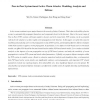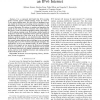92 search results - page 1 / 19 » Design space and analysis of worm defense strategies |
CCS
2006
ACM
13 years 8 months ago
2006
ACM
We give the first systematic investigation of the design space of worm defense system strategies. We accomplish this by g a taxonomy of defense strategies by abstracting away impl...
COMCOM
2008
13 years 4 months ago
2008
Active worms continue to pose major threats to the security of today's Internet. This is due to the ability of active worms to automatically propagate themselves and compromi...
INFOCOM
2005
IEEE
13 years 10 months ago
2005
IEEE
— It is a commonly held belief that IPv6 provides greater security against random-scanning worms by virtue of a very sparse address space. We show that an intelligent worm can ex...
INFOCOM
2003
IEEE
13 years 10 months ago
2003
IEEE
— It has been clear since 1988 that self-propagating code can quickly spread across a network by exploiting homogeneous security vulnerabilities. However, the last few years have...
CN
2007
13 years 4 months ago
2007
Worms are self-replicating malicious programs that represent a major security threat for the Internet, as they can infect and damage a large number of vulnerable hosts at timescal...


